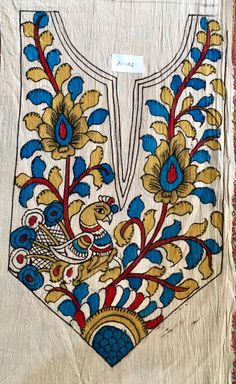Kalamkari Design 04
Kalamkari, an ancient Indian textile art form, has gained immense popularity in contemporary fashion, particularly in the design of kurtis. Known for its intricate hand-painted and block-printed motifs, Kalamkari offers a vibrant narrative that reflects India’s rich cultural heritage. The fusion of traditional craftsmanship with modern aesthetics has made Kalamkari kurtis a sought-after choice for fashion enthusiasts. This article explores the unique characteristics, history, techniques, and contemporary relevance of Kalamkari designs on kurtis.
Historical Background of Kalamkari

Kalamkari has its roots in ancient India, with origins tracing back to the Mahabharata and Ramayana. Traditionally, it was practiced in the regions of Andhra Pradesh and Telangana, where artisans created textiles for temples, rituals, and royal patrons. The term “Kalamkari” translates to “pen work,” highlighting the meticulous technique involved in the craft.
During the Mughal era, Kalamkari flourished, incorporating Persian influences and becoming more refined. Artisans used natural dyes derived from plants and minerals, ensuring that each piece was not only a work of art but also sustainable and environmentally friendly. As the craft evolved, it began to reflect local stories, deities, and nature, creating a diverse array of designs.
Characteristics of Kalamkari Designs
Intricate Patterns
Kalamkari is known for its elaborate and intricate designs. These patterns often depict mythological narratives, floral motifs, and geometric shapes. The hand-painted or block-printed techniques allow artisans to create detailed illustrations that tell stories through fabric.
Vibrant Colors
One of the most striking features of Kalamkari designs is the use of vibrant, natural colors. Dyes from indigo, turmeric, pomegranate, and other plants produce rich hues that add depth and life to the fabric. This use of natural dyes not only enhances the aesthetic appeal but also contributes to the sustainability of the garments.
Cultural Narratives

Kalamkari kurtis often feature designs that reflect cultural stories and spiritual themes. Common motifs include depictions of Hindu deities, scenes from epics, and symbols of nature. Wearing a Kalamkari kurti can feel like donning a piece of art that carries historical and cultural significance.
Techniques of Kalamkari
Hand-Painting
In hand-painted Kalamkari, artisans use a tamarind stick, which is sharpened to a point, to draw intricate designs. The process is labor-intensive, requiring a steady hand and a keen eye for detail. The fabric is first treated to ensure the colors adhere well, and artisans may spend several days on a single piece.
Block-Printing
Block-printing is another technique used in Kalamkari, where artisans carve designs into wooden blocks, dip them in natural dyes, and stamp them onto fabric. This method allows for the production of repeated patterns and is often used to create larger quantities of kurtis while maintaining the integrity of the design.
Dyeing Process
The dyeing process is crucial to the creation of Kalamkari kurtis. Fabrics are pre-treated to ensure vibrant colors. Natural dyes are extracted from plants and minerals, and the fabric undergoes multiple dyeing stages to achieve the desired colors. This careful process results in textiles that are both beautiful and durable.
Kalamkari Kurtis: A Fashion Statement
Versatility
Kalamkari kurtis are versatile garments that can be worn on various occasions. They can be styled for casual outings, festive celebrations, or even formal events, depending on the design and embellishments. Their unique aesthetic makes them a favorite among women of all ages.
Comfort and Breathability
Made from natural fabrics like cotton and linen, Kalamkari kurtis offer excellent breathability and comfort. This makes them suitable for both warm and cool weather, ensuring that the wearer feels comfortable throughout the day. The soft texture of the fabric adds to the overall appeal.
Customization and Personal Expression
Many artisans and designers offer customized Kalamkari kurtis, allowing individuals to choose specific designs, colors, and styles. This personalization fosters a connection between the wearer and the garment, making it a true reflection of individual taste and identity.
Contemporary Trends
Fusion Fashion

In recent years, Kalamkari designs have seen a revival in modern fashion, particularly in fusion wear. Designers are experimenting with contemporary cuts and silhouettes while retaining traditional motifs. This blend of styles appeals to younger audiences who appreciate the cultural significance of Kalamkari but also seek modern aesthetics.
Sustainable Fashion
With an increasing focus on sustainable fashion, Kalamkari has found a significant place in the eco-friendly movement. The use of natural dyes and handcrafted techniques aligns with the values of consumers who prioritize sustainability. Wearing a Kalamkari kurti not only showcases style but also supports ethical practices in the fashion industry.
Global Appeal
Kalamkari kurtis are gaining recognition beyond Indian borders. International designers and fashion enthusiasts are incorporating Kalamkari motifs into their collections, celebrating the art form’s uniqueness. This global interest helps promote Indian craftsmanship and provides artisans with new markets for their work.
Challenges Faced by Kalamkari Artisans
Despite its revival, Kalamkari artisans face several challenges:
Economic Viability
Many artisans struggle to earn a sustainable income due to the labor-intensive nature of Kalamkari. The market is often flooded with cheaper, mass-produced alternatives that can overshadow handmade products.
Preservation of Techniques
As modern techniques and synthetic dyes gain popularity, traditional Kalamkari methods risk being forgotten. It is crucial to document and teach these techniques to ensure their preservation for future generations.
Access to Resources
Artisans often face difficulties in accessing quality raw materials, such as natural dyes and high-quality fabrics. Improving supply chains and providing resources can significantly enhance their livelihoods.
Conclusion

Kalamkari designs on kurtis represent a beautiful blend of tradition and contemporary fashion. With their intricate patterns, vibrant colors, and cultural narratives, these garments not only serve as a statement of style but also as a celebration of India’s rich heritage. As the art form continues to evolve, it offers a unique opportunity for self-expression and connection to cultural roots.
By embracing Kalamkari kurtis, wearers support sustainable fashion practices and empower artisans, ensuring that this ancient craft thrives in the modern world. Each piece of Kalamkari art tells a story, making it more than just clothing; it becomes a wearable expression of history, culture, and individuality.
